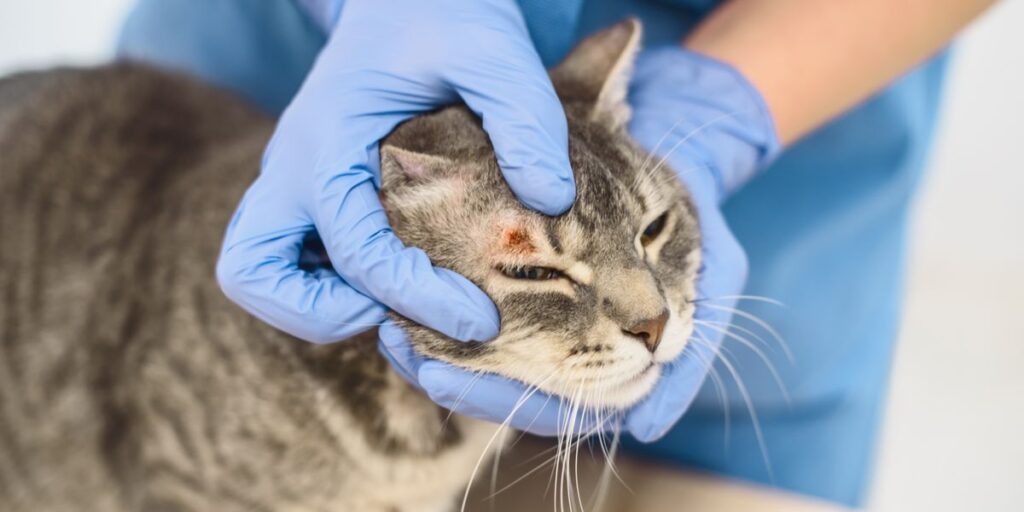Cat ringworm, despite its name, isn’t caused by worms but by a group of fungi called dermatophytes. These fungi live on the surface of the skin, feeding on keratin found in the fur, skin, and nails. Highly contagious and common among cats, especially in shelters, understanding ringworm is essential for every pet owner.
Here’s what you need to know about ringworm in cats—from spotting the signs to preventing its spread and treating your furry friend effectively.
What Are the Signs of Ringworm in Cats?
Ringworm can manifest differently depending on the severity of the infection, but common symptoms include:
- Hair Loss: Circular patches of missing fur, often red or scaly.
- Itchy or Inflamed Skin: Cats may excessively groom or scratch the affected areas.
- Broken Hairs: Fur that appears brittle or stubbly.
- Crusting or Scaling: Flaky skin, especially on the ears, face, or paws.
- Nail Damage: Discolored or deformed nails if the fungi spread there.
Some cats might not show any visible signs but can still carry and spread the infection, making early detection key.
How Does Cat Ringworm Spread?
Ringworm is highly contagious and spreads through:
- Direct Contact: Touching an infected cat or animal.
- Environment: Fungal spores can linger in bedding, furniture, carpets, and other surfaces for months.
- Grooming Tools or Toys: Sharing brushes, combs, or other items.
Kittens, senior cats, or those with compromised immune systems are more susceptible to infection. Humans can also contract ringworm from cats, making it a zoonotic condition.
Diagnosing Ringworm in Cats
If you suspect ringworm, it’s crucial to seek a veterinarian’s diagnosis to confirm. Common diagnostic methods include:
- Woods Lamp Test: A special ultraviolet lamp that highlights certain fungal types with a fluorescent glow.
- Fungal Culture: A sample of hair or skin is tested to identify the specific fungal strain.
- Microscopic Examination: Viewing skin scrapings or hair under a microscope for fungal spores.
Timely diagnosis is vital for initiating proper treatment and limiting spread.
How Is Cat Ringworm Treated?
Treatment depends on the infection’s severity and the number of affected animals in the household. A combination of treatments is often used:
- Topical Treatments:
- Antifungal creams, lotions, or shampoos applied to the affected areas.
- Lime sulfur dips are commonly used in severe cases.
- Oral Medications:
- Antifungal pills prescribed for widespread or stubborn infections.
- Medications like itraconazole or terbinafine target the fungus internally.
- Environmental Decontamination:
- Regular cleaning of all surfaces, furniture, and pet bedding.
- Vacuuming carpets and upholstery to remove spores.
- Disinfecting with antifungal solutions like diluted bleach (1:10 ratio).
- Isolating the Infected Cat:
- Minimizing contact between infected and healthy pets or humans.
- Using separate grooming tools, toys, and bedding.
Treatment can take several weeks to months, depending on the response to therapy and environmental management.
Preventing Ringworm
- Routine Health Checks: Regularly inspect your cat’s skin and fur for signs of infection.
- Good Hygiene: Wash your hands after handling pets, especially if they’ve been exposed to other animals.
- Clean Environment: Keep your cat’s living spaces clean and well-maintained.
- Regular Grooming: Use pet-specific grooming tools and clean them thoroughly.
Cat ringworm in cats may be a nuisance, but with proper care and attention, it is both manageable and treatable. This common fungal infection affects the skin, fur, and claws, often appearing as circular patches of hair loss, scaly skin, or redness. While it may not cause serious harm, it can be highly contagious, spreading easily to other pets and even humans. Early detection is crucial, as recognizing the symptoms and seeking treatment promptly can significantly speed up your cat’s recovery.
Swift action, including veterinary care, antifungal medications, and thorough environmental cleaning, not only helps your feline friend heal faster but also minimizes the risk of the infection spreading throughout your home. By staying proactive and diligent in treatment, you can ensure your cat’s health and well-being while keeping the rest of your household safe.
By maintaining good hygiene and promptly addressing any signs of ringworm, you’ll keep your feline friend healthy and your home fungus-free!
